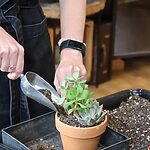Schlumbergera Truncata Thanksgiving Cactus
From: £5.00Schlumbergera is a stunning and unique plant that is perfect for adding a pop of colour to any space. Also known as the Thanksgiving Cactus close cousin of the Christmas and Easter Catus. This plant is a member of the cactus family and is native to the rainforests of Brazil.
The Schlumbergera is a low-maintenance and pet-friendly plant that features flat, segmented leaves that grow in a cascading fashion, with colourful and showy blooms emerging from the tips of each segment. Typically flowers appear in the winter months but sometimes plants bloom almost all year around.
This plant thrives in bright light and prefers well-draining soil. It is easy to care for, as it requires minimal watering and can tolerate a range of temperatures.
Please note plants are in different stages of blooming, some have flowers, some are already flowered and others getting ready to bloom.












